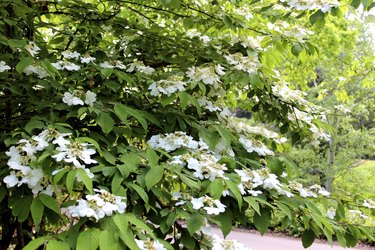
Some trees and shrubs shine one season and then fade away as the year wears on. Evergreen viburnums (Viburnum spp.) turn that cycle upside down by delighting gardeners year-round. With varieties hardy from U.S. Department of Agriculture plant hardiness zones 5 through 10, these garden standouts provide ornamental features that change with the seasons. From glossy foliage and long-lasting flowers to brightly colored, late-season fruit, evergreen viburnums keep the beauty rolling.
David Viburnum
Video of the Day
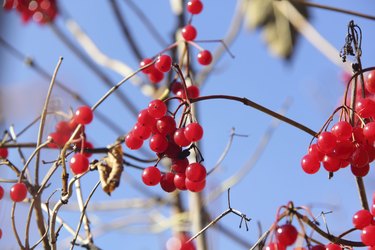
Hardy in USDA zones 7 through 9, David viburnum (Viburnum davidii) spreads no higher than 3 feet as it combines striking, blue-green foliage with clusters of pink flower buds. They unfold as white blooms in April and May, giving way to summer berries. Light green on emerging, the fruit transitions to pink, red, and finally metallic turquoise. The berries attracts birds to the garden well into winter. The shrub requires both male and female plants for fruit. David viburnum does best where summers are cool. It benefits from afternoon shade in hot summer climates and grows best in consistently moist, well-drained soil.
Video of the Day
Laurustinus Viburnum
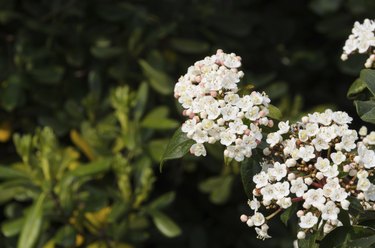
Laurustinus viburnum (Viburnum tinus), hardy in USDA zones 7b through 10, is an upright, dense plant standing between 6 and 12 feet high and up to 10 feet wide. Its glossy, deep green leaves grow up to 4 inches long and contrast well with the pink buds and flat clusters of waxy, white blooms that appear from late winter to spring. The dark blue or black berries shine with a metallic sheen. This round, dense bush tolerates both drought and wet coastal locations. It likes well-drained moist soil and full sun to partial shade.
Sweet Viburnum
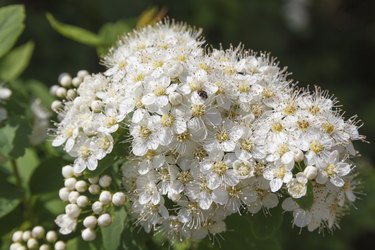
The popular sweet viburnum tree (Viburnum odoratissimum) grows up to 30 feet high and wide unless pruned into a hedge. Hardy in USDA zones 8b through 10a, it has glossy, deep green leaves between 4 and 8 inches long. Abundant clusters of sweetly scented, white flowers nearly conceal its foliage in the spring. Red berries that age to black follow the blossoms. Sweet viburnum tolerates drought and a wide range of well-drained soils. It grows in full sun to partial shade.
Walter's Viburnum
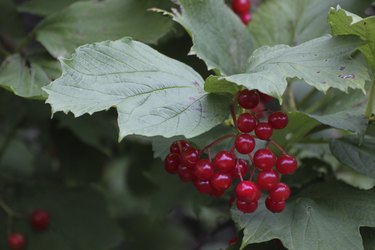
Walter's viburnum (Viburnum obovatum) grows between 8 and 25 feet high and up to 10 feet wide. Hardy from USDA zones 7 through 10, it has fragrant, small-to-medium, deep green leaves. Clusters of aromatic white flowers almost cover the plant in late winter. Its berries, red when new, ripen to black. This drought-tolerant viburnum is available in weeping, spreading, upright and dwarf forms. It performs best in full to partial sun and well-drained soil.